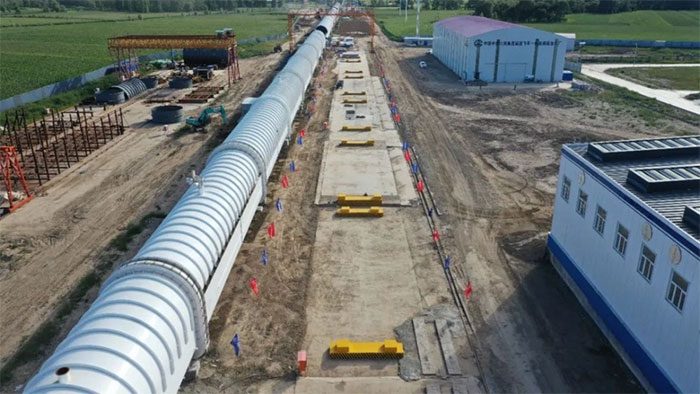The latest breakthrough in the development of super-fast trains, often referred to as “flying trains on the ground” , was achieved by China with the completion of the main project for Phase 1 of the test track for super-fast trains in Datong City, Shanxi Province, in the northern part of the country, which was finished in November. This signifies that China has completed the vacuum tube necessary for testing trains at speeds of 1,000 km/h.
Earlier this year, in January, Chinese engineers successfully conducted a high-speed maglev train test within a low-friction vacuum tube for the first time. This also marked the first successful trial of a train system utilizing hyperloop technology, which offers several advantages over conventional high-speed train technology, in China.

Test track for super-fast trains in Datong, Shanxi, China. (Photo: Shanxi Daily).
Li Ping, a member of the “flying train” project team from the China Aerospace Science and Industry Corporation, shared with local media: “The flying train has transitioned from a static state to a dynamic one. This is an integrated trial of the entire system, meaning it integrates multiple subsystems. Through this trial, we can initially verify the scientific rationality of the overall design of the flying train.”
During the test, the maglev train prototype completed three runs in a superconducting maglev test tube. The results indicated that the train operated normally when its speed exceeded 50 km/h on the 210-meter test track.
The test track project for super-fast trains in Datong City was approved in September 2021 and construction began in April 2022. To accelerate progress, the project team applied a model of “construction, integration, and testing simultaneously” and completed the infrastructure of the testing facility along with the first section of the test track, as well as the integration of equipment and testing of the entire process in less than a year. Currently, the vacuum tube used for testing is only 2 kilometers long.
Li Ping added: “Our goal is to achieve a speed of 1,000 km/h. Next, we will conduct more tests on the test track of Phase 1 in Datong to verify the reliability of the entire system. In the following steps, we will extend the test track and then perform some verifications over longer distances and at higher speeds.”
It is known that from the proposal made in 2017 for the ultra-high-speed rail project incorporating magnetic levitation technology, supersonic flight technology, and vacuum tube technology, China has set a three-step plan with three targets of 1,000 km/h, 2,000 km/h, and 4,000 km/h.
This super-fast train could be used for transportation between super metropolitan clusters in the future. The South China Morning Post recently quoted Chinese scientists in an article published in the journal “Railway Standard Design” indicating that through their research, they have selected six railway routes that are most suitable for implementing the super-fast train project. Among these, the 150 km route connecting the two wealthy cities on the eastern coast, Shanghai and Hangzhou, is considered the most feasible. If put into operation, it would take only 9 minutes to travel between these two locations.
However, experts point out that achieving the speed goal of 1,000 km/h is unlikely to happen overnight and requires numerous tests.
Currently, China operates the largest high-speed rail network in the world, with a total length exceeding 42,000 km and speeds of up to 400 km/h. In reality, the concept of super-fast trains is not new, as it was initially proposed by American entrepreneur Elon Musk in 2012. However, with the existing high-speed rail technology foundation and strong government support, this idea is likely to become a reality in China in the near future.


















































